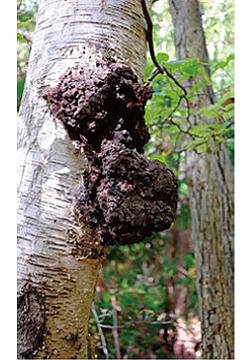Chaga as a folk medicine
Chaga (Inonotus obliquus; Japanese name: Chaga mushroom) is a cold-tolerant mushroom that parasitizes the trunks of birch species, such as the Japanese white birch, by breaking the bark and forming a solid black sclerotium (Photo 1). It is widely distributed in the Northern Hemisphere, from temperate zones to subarctic zones; in Japan, it is distributed in the Hokkaido region, Tohoku region, Nagano Prefecture, and other nearby areas. The Soviet writer Alexander Isayevich Solzhenitsyn, who won the Nobel Prize in Literature in 1970, briefly touches on the medicinal properties of chaga in the chapter "Cancer of the Birch Tree" in his book Cancer Ward: "Cancer is rarely seen in peasant patients who come to a particular hospital where a doctor from the suburbs of Moscow has been working for decades. After investigating, I found that the peasants in the area were brewing chaga, i.e., birch fungus, to save money on their tea." In fact, chaga has been used as a folk medicine for cancer for more than four centuries in Russia and West Siberia. Because of this, research focusing on the antitumor effect of chaga has been performed worldwide. Chaga has also been reported to have antioxidant, anti-inflammatory, and protective effects against diseases such as diabetes and arteriosclerosis. Therefore, in Japan, its use as a functional food is being considered, and crushed chaga mushrooms in powdered or liquid culture solutions are sold as health teas.

Immediate implementation! Blessed with a smooth process
Based on an academic exchange agreement with the Mongolian University of Health Sciences (currently named Mongolian National University of Medical Sciences), which concluded on October 5, 2007, Tokushima University will, "provide guidance and education in the fields of pharmacognosy and natural product chemistry and promote joint research on natural medicinal resources, including medicinal plants." In 2012, Associate Professor Kikuji Yamashita (currently a professor at Niigata University of Pharmacy and Applied Life Sciences), Graduate School of Medicine, Dentistry, and Pharmaceutical Sciences, University of Pharmacy, obtained the following information from an international student from Mongolia, "In Mongolia, there are regions where broths made of herbs, such as Chaga and Plantago major, are traditionally used as hair wash agents in which the hair is soaked before washing." These practices are believed to be cultural remedies for maintaining black hair. Associate Professor Yamashita studied the effects of the extracts on various metabolic enzyme activities and developed research on hair growth activity.
At that time, I belonged to the Intellectual Property Headquarters, Industry-Academia-Government Collaboration Promotion Department, University of Tokushima, and was in charge of applying for a patent for this research (PCT/JP2013/082322). Then, as part of this technology transfer, it was exhibited at "BIOtech 2013" held at Tokyo Big Sight from May 8-10, 2013, to introduce the results of this research. Associate Professor Yamashita was asked to give an oral presentation on "Chaga's hair growth and hair growth effect" at Academic Forum. At that time, information was obtained from 'Mr. T', who belonged to a certain audit corporation and who stopped in front of the Tokushima University booth, that, "an acquaintance would be interested in this matter." That acquaintance was then introduced to Professor Yamashita. On May 27, 2013, a direct mail was sent to this acquaintance, 'Mr. I' of Svenson Co., Ltd. In that first greeting email, an interview was requested, and a visit to the headquarters office of Svenson Co., Ltd. in Tokyo (Minato Ward) with Associate Professor Yamashita was made on June 20. As the referrer had said, they were interested in this matter and decided to consider it. Professor Yamashita promptly provided 17 g of chaga dried extract powder (on July 11, a sales contract for this tangible research product was concluded). At Svenson, a question-and-answer session with Associate Professor Yamashita continued, and there was a plan to confirm the solubility of the sample and the compatibility between the simple substance and the compounding ingredients, as well as to test its dyeing potential on hair and its effects on hair growth.
On November 14, 'Mr. I' and Mr. Takatoshi Fukumoto, Director of the hair care marketing division of the company, who is responsible for the development of this idea, came to Tokushima University and exchanged detailed opinions on the results of experiments conducted on the raw materials for chaga to date. Consultation for competitive fund acquisition aimed at joint research and development was also carried out. On January 28, 2014, a visit was made to the Japan Science and Technology Agency (JST), alongside Mr. Fukumoto to introduce the appropriate business to the person in charge. A joint application for the A-STEP industry-academia joint promotion stage (high-risk challenge type) as, "demonstration of the hair growth effect of chaga and basic evaluation for hair care product application," was submitted, but unfortunately this application was not accepted. However, a thankful request was received from Svenson Co., Ltd., "in the medium-term plan, we would like to jointly conduct research on the practical application of chaga extract raw material as a new raw material for quasi-drugs with scientific evidence of hair growth effect." From this, a joint research contract was signed on May 8, 2014. The purpose was to conduct research on basic evaluations for using chaga in hair care products (quasi-drugs and cosmetics) (quasi-drugs: hair growth effect and cosmetic moisturizing effect). As the experiment progressed, the question as to which component of the chaga hot water extract was the active ingredient causing the hair growth effect to arise. To answer this question, other researchers on campus were introduced to this project to proceed with exploratory research on active ingredients at the campus.
Meanwhile, as part of the abovementioned agreement, the Pharmacognosy Laboratory of Professor Yoshiki Kashiwada of the Graduate School of Pharmaceutical Sciences (Pharmacy) was conducting research on valuable drug information handed down by the Mongolian people and the components contained in medicinal plants aiming at new drug discovery (2010-2012 Basic Research B, "study on traditional drug research of the Mongolian people and its effective use."). This was a study to isolate new compounds from Mongolian plants and clarify their chemical structures. In addition, by examining the chemical modification and anti-HIV activity of triterpenes, which are present in large amounts in the bark of white birch, Professor Kashiwada discovered that a betulinic acid derivative (bevirimat) found in the bark showed extremely strong anti-HIV properties. He had experience in clinical application trials in the United States. Professor Kashiwada was interested in studying chaga, and a new joint research agreement concluded on May 14, 2015. Thankfully, he was able to act as a bridge between researchers on campus.
The foundation for research was established, thanks to the adoption of the JST A-STEP Matching Planner Program
For identifying the compounds present in chaga that have hair growth effects, it was essential to establish an activity evaluation system. Initially, an evaluation system using metabolic enzymes involved in hair growth was investigated. However, since it did not correspond to the results of previous experiments, it was judged difficult to search using this evaluation system as an index. Thus, a major problem arose quite early on during the beginning of the study. To solve this issue, in consultation with Director Fukumoto, Svenson was asked to evaluate the proliferation-promoting effect of hair papilla cells, testosterone 5α-reductase inhibitory activity, androgen receptor antagonistic activity, and expression-regulating activity of genes involved in the hair cycle. The results of this activity assessment revealed that the 80% ethanol extract of chaga promotes dermal papilla cell proliferation at lower concentrations than the positive control, minoxidil. Thus, it was found that the hair papillary cell proliferation promoting activity of chaga extract surpasses that of the prescription drug minoxidil. Based on these results, a full-fledged study to explore the hair growth effects of chaga and the active ingredients, using human hair papilla cell proliferation-promoting activity as an index, has been initiated.
This research plan was submitted to the JST 2015 1st Matching Planner Program "Exploration Test" and was adopted as, "development of a new hair care product using the Mongolian natural drug chaga as a material." By being adopted in this program, we were able to establish an evaluation system for the basis of our research in this laboratory. As a result of exploratory research using this evaluation system, multiple compounds centered on lanosterol, a lanostane-type triterpene, were identified as dermal papilla cell-promoting active ingredients. A joint patent application (PCT/JP2018/024979) between Svenson and Tokushima University was filed, and a paper was published in an international academic journal (J. Nat. Med. 2019, 73, 597-601).
The game of catch between companies and universities continues
It took 8 years from the encounter between Svenson and Tokushima University until the press releases for the Chaga Medicinal Scalp Shampoo (on June 1, 2021) and Chaga Medicinal Hair Growth Agent (on June 17, 2021) were published (Photo 2). During this period, the exchanges between the two entities were, from start to finish, between myself and Director Fukumoto. Since the approval of applications for "quasi-drugs containing new active ingredients" is extremely difficult, Svenson has designated the 80% ethanol extract from chaga as "quasi-drug containing new additives." Nonclinical safety tests (acute "oral" toxicity tests, primary skin irritation tests, continuous skin irritation tests, eye irritation tests, etc.) were conducted, and the results were examined by the Pharmaceuticals and Medical Devices Agency (PMDA). Finally, the product was approved by the Ministry of Health, Labour and Welfare. Success in commercializing a hair restorer using chaga as a new material was at last achieved.

There was also the matter of a written opinion from an international search organization regarding the PCT application. On January 22, 2019, an interview, together with the company, was held with the examiner of the Japan Patent Office, and a patent decision in Japan was successfully obtained on July 30. Regarding the publication of research results, poster presentations were delivered at the 138th Annual Meeting of the Pharmaceutical Society of Japan in 2018 and oral presentations were delivered at the 46th Annual Meeting of the Pharmaceutical Society of Japan in 2021, and collaboration between Svenson and Tokushima University continued. Associate Professor Naonobu Tanaka of the Graduate School of Pharmaceutical Sciences (Pharmacy) is still conducting exploratory research on these ingredients (2020-2022 Basic Research C, "development research of new hair growth agents using the chaga mushroom."). In the future, further company collaboration with Svenson with the aim of optimizing active compounds and developing quasi-drugs into pharmaceuticals (hair growth and hair growth agents) is desired.
Finally, it is important for industry-academia collaboration to utilize this network and move to immediate implementation. There is no process that will work in all cases. Nevertheless, it is important to humbly learn about the empirical research and case reports of other researchers, think carefully, and move while accumulating one's own experience during on the job training.

Kazumi Sagayama,
Associate Professor, Intellectual Property Headquarters, co-appointed to Planning and Strategy Office, Organization for Research Strategy and Development, Okayama University.




